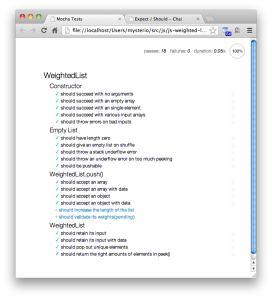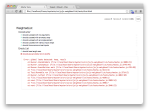It’s been a minute since my last update, during which time I’ve learnt a great deal about node.js as well as the whole AMD / CommonJS mess mentioned in my last post. Without drowning in detail, here are a few things I’ve been thinking about.
I’ve made the switch to CoffeeScript for a good deal of my Javascript code, mostly because I was worried about wearing out the keys on my keyboard which comprise the phrase function(){}. I rather enjoy CoffeeScript’s cleaned-up syntax, at least for now, and I like how it hews to Javascript’s essential character while smoothing out its rougher bits. I’ve still got plenty of reservations about it, and it sometimes errs a bit too far on the loosey-goosey side of the syntax fence for my taste, but anything that will save me from the ongoing insults to programming-language aesthetics coming out of the Javascript world has my sincere gratitude. (The latest of these I’ve had to endure is the comma-first style, which is just one of the awful emergent results from the most-used data transport format of our day, the JSON spec, needing to fit into three quarters of a page of EBNF for some reason. Why complicate it with an optional comma at the end, or optional quotes around key values? But that’s a rant for another day.)
Meanwhile I also went down a fairly long rabbit hole in learning about electronics – this started with getting a Raspberry Pi and then got a little more low-level with some Ardiuno stuff, and by now I’ve got a bunch of nascent electronics projects in the offing, mostly concerning various robots. The Pi in particular has a robust Python infrastructure, and I have a pretty good imaging-related project in mind, but in the course of writing the software for it I decided that this would be a good opportunity to experiment with node.js development, and so I’ve since ported the stuff I’d written from Python to CoffeeScript and node.js.
More is surely to come about all that, and as usual I ought to have some code available on github before too long. In the course of all this I’ve also learned a great deal more about the server-side javascript ecosystem, and I think I should actually be ready to get the weighted-probability list library into much better shape.


 .
.